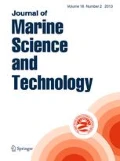Abstract
In a shipyard, line heating and triangle heating are two major processes carried out by skilled workers to form curved plates in various shapes under various heating conditions. There have been many studies on line heating, but triangle heating has rarely been studied owing to its complicated heating process with irregular multiheating paths and highly concentrated heat input. Triangle heating is the most labor-intensive job. Hence, it is essential for most shipyards to study the automation, as well as the improvement, of the triangle heating process in order to increase hull-forming productivity. In this study, a pioneering attempt to simulate triangle heating was made. A circular disk-spring model is proposed as an analysis model for the elastoplastic procedure of triangle heating, and the inherent strain method is also used to analyze the deformation of plates. The results of the simulation were compared with those of experiments and showed good agreement. It is shown that the present approach and the model used in this study are effective and efficient for simulating triangle heating for the steel plate forming process in shipbuilding.
Similar content being viewed by others
References
CD Jang SI Seo DE Ko (1997) ArticleTitleA study on the prediction of deformations of plates due to line heating using a simplified thermal elasto-plastic analysis J Ship Prod 13 1
JG Shin A Moshaiov (1991) ArticleTitleModified strip model for analyzing the line heating method. Part 1. Elastic plates J Ship Res 35 2
CD Jang YS Ha DE Ko et al. (2002) ArticleTitleDetermination of inherent strain region for plate bending analysis due to line heating J Soc Nav Archit Korea 39 1
Nomoto T, Ohmori T, Satoh T, et al (1990) Development of simulator for plate bending by line heating. J Soc Nav Archit Jpn 168
Watanabe M, Satoh K (1961) Effect of welding conditions on the shrinkage distortion in welded structures. Welding J 40
SI Seo CD Jang (1999) ArticleTitleA study on the prediction of deformations of welded ship structures J Ship Prod 15 2
CD Jang SI Seo YH Yang (2001) ArticleTitleDevelopment of a new finite element analysis of deformation of plate due to line heating J Ship Prod 17 1
Y Ueda T Yamakawa (1973) ArticleTitleAnalysis of thermal elastic-plastic behavior of metals during welding by finite element method J Jpn Welding Soc 42 6
Author information
Authors and Affiliations
Corresponding author
About this article
Cite this article
Jang, C., Kim, T., Ko, D. et al. Prediction of steel plate deformation due to triangle heating using the inherent strain method. J Mar Sci Technol 10, 211–216 (2005). https://doi.org/10.1007/s00773-005-0202-5
Received:
Accepted:
Issue Date:
DOI: https://doi.org/10.1007/s00773-005-0202-5




